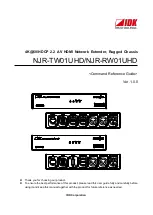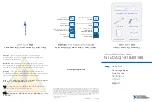
1-66
Cisco ASA Series CLI Configuration Guide
Chapter 1 Configuring Connection Profiles, Group Policies, and Users
Group Policies
hostname(config-group-policy)#
ipsec-udp
{
enable
|
disable
}
hostname(config-group-policy)#
no ipsec-udp
To use IPsec over UDP, you must also configure the
ipsec-udp-port
command, as described in this
section.
To disable IPsec over UDP, enter the
disable
keyword. To remove the IPsec over UDP attribute from the
running configuration, enter the
no
form of this command. This enables inheritance of a value for IPsec
over UDP from another group policy.
The Cisco VPN client must also be configured to use IPsec over UDP (it is configured to use it by
default). The VPN 3002 requires no configuration to use IPsec over UDP.
The following example shows how to set IPsec over UDP for the group policy named
FirstGroup:
hostname(config)#
group-policy FirstGroup attributes
hostname(config-group-policy)#
ipsec-udp enable
If you enabled IPsec over UDP, you must also configure the
ipsec-udp-port
command in group-policy
configuration mode. This command sets a UDP port number for IPsec over UDP. In IPsec negotiations,
the ASA listens on the configured port and forwards UDP traffic for that port even if other filter rules
drop UDP traffic. The port numbers can range from 4001 through 49151. The default port value is 10000.
To disable the UDP port, enter the
no
form of this command. This enables inheritance of a value for the
IPsec over UDP port from another group policy.
hostname(config-group-policy)#
ipsec-udp-port
port
The following example shows how to set an IPsec UDP port to port 4025 for the group policy named
FirstGroup:
hostname(config)#
group-policy FirstGroup attributes
hostname(config-group-policy)#
ipsec-udp-port 4025
Configuring Attributes for VPN Hardware Clients
This section describes how to enable or disable secure unit authentication and user authentication or set
a user authentication timeout value for VPN hardware clients. They also let you allow Cisco IP phones
and LEAP packets to bypass individual user authentication and allow hardware clients using Network
Extension Mode to connect.
Configuring Secure Unit Authentication
Secure unit authentication provides additional security by requiring VPN hardware clients to
authenticate with a username and password each time that the client initiates a tunnel. With this feature
enabled, the hardware client does not have a saved username and password. Secure unit authentication
is disabled by default.
Note
With this feature enabled, to bring up a VPN tunnel, a user must be present to enter the username and
password.
Secure unit authentication requires that you have an authentication server group configured for the
connection profile the hardware client(s) use. If you require secure unit authentication on the primary
ASA, be sure to configure it on any backup servers as well.
Specify whether to enable secure unit authentication by entering the
secure-unit-authentication
command with the
enable
keyword in group-policy configuration mode.
Summary of Contents for 5505 - ASA Firewall Edition Bundle
Page 28: ...Glossary GL 24 Cisco ASA Series CLI Configuration Guide ...
Page 61: ...P A R T 1 Getting Started with the ASA ...
Page 62: ......
Page 219: ...P A R T 2 Configuring High Availability and Scalability ...
Page 220: ......
Page 403: ...P A R T 2 Configuring Interfaces ...
Page 404: ......
Page 499: ...P A R T 2 Configuring Basic Settings ...
Page 500: ......
Page 533: ...P A R T 2 Configuring Objects and Access Lists ...
Page 534: ......
Page 601: ...P A R T 2 Configuring IP Routing ...
Page 602: ......
Page 745: ...P A R T 2 Configuring Network Address Translation ...
Page 746: ......
Page 845: ...P A R T 2 Configuring AAA Servers and the Local Database ...
Page 846: ......
Page 981: ...P A R T 2 Configuring Access Control ...
Page 982: ......
Page 1061: ...P A R T 2 Configuring Service Policies Using the Modular Policy Framework ...
Page 1062: ......
Page 1093: ...P A R T 2 Configuring Application Inspection ...
Page 1094: ......
Page 1191: ...P A R T 2 Configuring Unified Communications ...
Page 1192: ......
Page 1333: ...P A R T 2 Configuring Connection Settings and QoS ...
Page 1334: ......
Page 1379: ...P A R T 2 Configuring Advanced Network Protection ...
Page 1380: ......
Page 1475: ...P A R T 2 Configuring Modules ...
Page 1476: ......
Page 1549: ...P A R T 2 Configuring VPN ...
Page 1550: ......
Page 1965: ...P A R T 2 Configuring Logging SNMP and Smart Call Home ...
Page 1966: ......
Page 2059: ...P A R T 2 System Administration ...
Page 2060: ......
Page 2098: ...1 8 Cisco ASA Series CLI Configuration Guide Chapter 1 Troubleshooting Viewing the Coredump ...
Page 2099: ...P A R T 2 Reference ...
Page 2100: ......






































